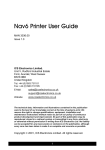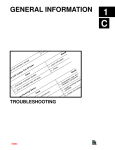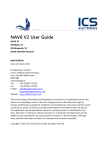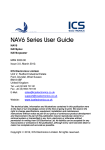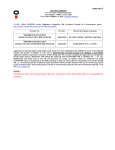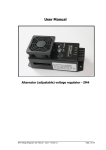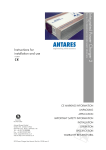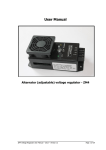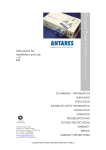Download pdf - Antares (Europe) Ltd.
Transcript
ASM2 Module Instructions for installation & use Battery Equaliser ASM2 User Manual - Part No 13202 Issue 6 Model Nos 70431, 90850, 90851, 90852, 90853 Page 1 of 28 PRODUCT LISTING APPLICATION IMPORTANT SAFETY INFORMATION INSTALLATION INSTALLATION DRAWINGS WARRANTY AND SERVICE ASM2 User Manual - Part No 13202 Issue 6 Model Nos 70431, 90850, 90851, 90852, 90853 Page 2 of 28 PRODUCT LISTING Code Product description and rating 90850 90851 90852 90853 70431 ASM2 12V/140A ASM2 24V/140A ASM2 12V/250A ASM2 24V/250A ASM2 12V/140A (e11022447) (e11022447) (e11022447) (e11022447) Options (e11022447) 90870 90871 90872 90873 90874 90875 90876 70128 70285 70286 70288 70312 70313 70339 70346 70358 70360 70362 70416 70422 71032 71033 ASM2 Assured Starting 12V or 24V ASM2 Load Shed 12V ASM2 Load Shed 24V ASM2 Deep Discharge Protection 12V ASM2 Deep Discharge Protection 24V ASM2 Remote Indication 12V ASM2 Remote Indication 24V ASM2 Mod for Bosch Regulator, Part Number F 00M 145 248 ASM2 Mod for Bosch Regulator, Part Number 1 197 311 558 ASM2 Mod for Prestolite Regulator, Part Number 8RG3119 ASM2 Service Aid for Modified Regulators ASM2 Mod for BES Alternator ASM2 Mod for Bosch Regulator, Part Number 1 197 311 213 ASM2 Mod for Bosch Regulator, Part Number 1 197 311 300 ASM2 Mod for Valeo Alternator, Part Number 254531A, A14 VI 42+ ASM2 Mod for Bosch Regulator, Part Number F 00M 145 256/302 ASM2 Mod for Bosch Regulator, Part Number F 00M 145 299 ASM2 Interface for Twin Bosch Regulators, Part Number F 00M 145 256 ASM2 Mod for Prestolite Regulator, Type 594A-9 ASM2 Mod for Bosch Regulator, Part Number F 00M 145 233 ASM2 to Twin N-type Alternator Interface ASM2 to Twin P-type Alternator Interface ASM2 User Manual - Part No 13202 Issue 6 Model Nos 70431, 90850, 90851, 90852, 90853 Page 3 of 28 APPLICATION (ASC) Automatic Split Charge (charge source connected to MAIN stud) The MAIN stud connection is monitored by a voltage sensing circuit, which controls the linking of the main and auxiliary batteries together. When a charging voltage (Vc) is detected at the MAIN stud, the Split Charge closes, allowing charging current from the alternator/charger to pass to the auxiliary battery. The Split Charge remains closed until the (combined) battery voltages fall to a level (Vh or Vo), indicating significant depth of discharge. The Split Charge will then open preserving a high level of charge in the main battery. Notes: 1. The following switching thresholds apply: - 12V/140A (70431/90850) 12V/250A (90852) Vc 12.9V +/- 0.1V Vh 12.7V +/- 0.1V Vo 12.3V +/- 0.1V 24V/140A (90851) 24V/250A (90853) 25.8 V +/- 0.2V 25.4V +/- 0.2V 24.6V +/- 0.2V 2. When the ASC is closed and the MAIN/AUX battery voltage falls to between Vh and Vo the ASC remains closed for approximately 30 sec before opening. Thus small short-term voltage reductions are ignored and the phenomenon of split charge cycling is minimised. 3. When the ASC is closed and the MAIN/AUX battery voltage falls to be less than Vo, the ASC opens in less than 3 seconds. (ASC) Automatic Split Charge (charge source connected to AUX stud) The AUX stud connection is monitored by a voltage sensing circuit, which controls the linking of the main and auxiliary batteries together. When a charging voltage (Vc) is detected at the AUX stud, the Split Charge closes, allowing charging current from the alternator/charger to pass to the main battery. The Split Charge remains closed until the (combined) battery voltages fall to a level (Vh or Vo), indicating significant depth of discharge. The Split Charge will then open preserving a high level of charge in the auxiliary battery. Notes: 1. The following switching thresholds apply: - 12V/140A (70431/90850) 12V/250A (90852) Vc 12.9V +/- 0.1V Vh 12.7V +/- 0.1V Vo 12.3V +/- 0.1V 24V/140A (90851) 24V/250A (90853) 25.8V +/- 0.2V 25.4V +/- 0.2V 24.6V +/- 0.2V 2. When the ASC is closed and the MAIN/AUX battery voltage falls to between Vh and Vo the ASC remains closed for approximately 30 sec before opening. Thus small short term voltage reductions are ignored and the phenomena of split charge cycling is minimised 3. When ASC is closed and the MAIN/AUX battery voltage falls to be less than Vo, the ASC opens in less than 3 seconds. ASM2 User Manual - Part No 13202 Issue 6 Model Nos 70431, 90850, 90851, 90852, 90853 Page 4 of 28 (APC) Alternator Power Controller (Alternator Regulator Disabled) Note: This mode of operation should not be applied with regulators that have an internally generated warning lamp output. Please refer to Antares (Europe) Limited for further advice. If the alternator regulator is disabled the APC can fully control the alternator output voltage. Thus, aided by remote sensors the battery charging voltage is optimised over the temperature range -40degC to +55degC. If the full temperature compensated voltage range is required: 12V/140A (70431/90850) 12V/250A (90852) 13.0V +/- 0.1V to 15.8V +/-0.1V 24V/140A (90851) 24V/250A (90853) 26.0V +/- 0.2V to 31.6V +/- 0.2V (controlled at the MAIN stud) the orange wire at S3 pin 6 must be connected to chassis (0V). If the full temperature compensated voltage range requires to be limited: 12V/140A (70431/90850) 12V/250A (90852) to 14.4V +/- 0.1V maximum 24V/140A (90851) 24V/250A (90853) to 28.8V +/- 0.2V maximum (controlled at the MAIN stud) then the orange wire at S3 pin 6 should be left unconnected and insulated. (APC) Alternator Power Controller (Alternator Regulator Enabled) Note: This mode of operation should not be applied with regulators that have an internally generated warning lamp output. Please refer to Antares (Europe) Limited for further advice. In this case, the APC will operate as above, except when its controlled voltage falls below that of the alternator regulator. When this happens the alternator regulator will take control of the alternator output voltage. The APC will resume operation only when its controlled voltage rises above that of the alternator regulator. (ASC) Automatic Split Charge Override (70431 only) If the interlock input (S2 pin 2) is driven low (by an HCMOS output) the split charge will be opened and/or remain open for the duration of this condition. In this way, conducted mode emissions from the main vehicle electrical system (e.g. from the alternator) can be reduced at the auxiliary system. Note that the duty cycle of this feature should be minimised to ensure that the auxiliary battery continues to receive sufficient charge from the alternator. If the interlock input (S2 pin 2) is driven high (by an HCMOS output) or is open circuit, the ASC operates normally for the duration of this condition. ASM2 User Manual - Part No 13202 Issue 6 Model Nos 70431, 90850, 90851, 90852, 90853 Page 5 of 28 Assured Starting (AST) Option (Not applicable to ASM2 70431/90850/90851) ASM2 12V/250A Pt No 90852 24V/250A Pt No 90853 AST Part No 90870 90870 If the main battery does not have enough charge to start the vehicle, depression of the AST momentary action switch causes the AST to operate closing the split charge contractor for a 30-second period. During this time, the auxiliary battery is connected to support the main battery when powering the starter motor. The 30-second period of operation is initiated each time the AST switch is depressed. Therefore, closure of the split charge contactor cannot be extended beyond this time by holding the switch continuously depressed. Thus the ASC system can continue to operate normally and the contacts of the contactor are protected from excessive periods of starter motor current. Load Shed (LS) Option ASM2 12V 24V Load Shed Option Part No 98071 90872 Selected auxiliary loads may be connected via the LS contactor to the auxiliary battery. When the auxiliary battery voltage remains at less than: 11.5V (12V ASM2) 23.0V (24V ASM2) for a 30-sec period the LS contactor will open to disconnect the loads thus reducing the battery discharge rate. The LS contactor will remain open until a charging voltage greater than or equal to: 12.9V (12V ASM2) 25.8V (24V ASM2) is detected at the “AUX” stud. ASM2 User Manual - Part No 13202 Issue 6 Model Nos 70431, 90850, 90851, 90852, 90853 Page 6 of 28 Deep Discharge Protection (DDP) Option ASM2 12V 24V Deep Discharge Protection Part No 90873 90874 Selected auxiliary loads may be connected via the DDP contactor. When the auxiliary battery voltage remains at less than: 10.5V (ASM2 12V) 21.0V (ASM2 24V) for a 60-sec period the DDP contactor will open to protect the auxiliary battery from further discharge. The DDP contactor will remain open until a charging voltage greater than or equal to: 12.9V (ASM2 12V) 25.8V (ASM2 24V) is detected at the “AUX” stud. ASM2 User Manual - Part No 13202 Issue 6 Model Nos 70431, 90850, 90851, 90852, 90853 Page 7 of 28 System Monitoring, Enclosure Indication (not available on 70431) and Remote Indication Option SUMMARY Condition Enclosure Indicators (not available on 70431) Remote Display Indicators (optional) Status 1 Status 2 Alternator Aux. system short circuit or no battery present flashes flashes System link flashes Main system short circuit flashes flashes flashes Main battery terminal temperature out of range Main system over voltage detected flashes flashes flashes flashes Aux. system high voltage flashes flashes Internal Split charge contacts damaged on flashes flashes flashes Aux. battery terminal temperature out of range Load shed will operate in 30 seconds on flashes flashes flashes Disconnect flash every second Load shed has operated flash every ten seconds Deep discharge protection will operate in 60 seconds flash five per second Deep discharge has operated flash every three seconds Alternator Power Control Operating Split Charge “system link” on on ASM2 User Manual - Part No 13202 Issue 6 Model Nos 70431, 90850, 90851, 90852, 90853 Page 8 of 28 on on System Monitoring, Enclosure Indication (not available on 70431) and Remote Indication Option (Cont.) ASM2 12V 24V Part No 90875 90876 1. The ASC will not close when the AUX stud voltage is less than: (12V ASM2) 1.0V+/- 0.1V (24V ASM2) 2.0V +/- 0.2V. This protects the ASC from damage if a short circuit develops in the auxiliary system. Status Indicator 1 off Status Indicator 2 flashes Remote Indicators: “system link” led flashes “alternator” led flashes 2. The ASC will not close and the AST (90852 and 90853 versions) will not operate when the MAIN stud voltage is greater than: (12V ASM2) 16.0V +/- 0.1V (24V ASM2) 32.0V +/- 0.2V. This protects the auxiliary system from overvoltage conditions. Status Indicator 1 off Status Indicator 2 flashes Remote Indicators: “system link” led off “alternator” led flashes 3. When the ASC is closed or the AST (90852 and 90853 versions) is operating and the MAIN stud voltage rises above: (12V ASM2) 16.0V +/- 0.1V (24V ASM2) 32.0V +/- 0.2V the split charge will open within 3 seconds. This protects the auxiliary system from overvoltage conditions. Status Indicator 1 off Status Indicator 2 flashes Remote Indicators: “system link” led off “alternator” led flashes 4. The ASC will not close when the MAIN stud voltage is less than: (12V ASM2) 1.0V +/- 0.1V (24V ASM2) 2.0V +/- 0.2V. This protects the ASC from damage if a short circuit develops in the main system. Status Indicator 1 off Status Indicator 2 flashes Remote Indicators: “system link” led flashes “alternator” led flashes 5. The ASC will not close and the AST (90852 and 90853 versions) will not operate when the AUX stud voltage is greater than: (12V ASM2) 16.0V +/- 0.1V (24V ASM2) 32.0V +/- 0.2V. This protects the main system from overvoltage conditions. Status Indicator 1 off Status Indicator 2 flashes Remote Indicators: “system link” led off “alternator” led flashes ASM2 User Manual - Part No 13202 Issue 6 Model Nos 70431, 90850, 90851, 90852, 90853 Page 9 of 28 6. When the ASC is closed or the AST (90852 and 90853 versions) is operation and the AUX stud voltage rises above: (12V ASM2) 16.0V +/- 0.1V (24V ASM2) 32.0V +/- 0.2V the split charge will open within 3 seconds. This protects the main system from overvoltage conditions. Status Indicator 1 off Status Indicator 2 flashes Remote Indicators: “system link” led off “alternator” led flashes 7. When the ASC is closed or the AST (90852 and 90853 versions) is operating and the voltage at the MAIN stud is not within: (12V ASM2) 0.5V +/- 0.1V (24V ASM2) 1.0V +/- 0.2V of the voltage at the AUX stud then a fault is indicated. Thus, damage to the contacts of the split charge switch can be detected. Status Indicator 1 on Status Indicator 2 flashes Remote Indicators: “system link” led flashes “alternator” led flashes 8. A fault will be indicated if the following conditions occur at the main battery temperature sensor. Temperature is greater than Temperature is less than Temperature sensor fault +58 degC +/-3 degC -43 degC +/- 3 degC In addition the APC will control the alternator voltage at the default setting of: (12V ASM2) 13.0V +/- 0.1V (24V ASM2) 26.0V +/- 0.2V measured at the MAIN stud. Status Indicator 1 off Status Indicator 2 flashes Remote Indicators: “system link” led off “alternator” led flashes 9. A fault will be indicated if the following conditions occur at the auxiliary battery temperature sensor. Temperature is greater than Temperature is less than Temperature sensor fault +58 degC +/-3 degC -43 degC +/- 3 degC In addition the APC will control the alternator voltage at the default setting of: (12V ASM2) 13.0V +/- 0.1V (24V ASM2) 26.0V +/- 0.2V measured at the MAIN stud if the split charge contactor is closed. Status Indicator 1 on Status Indicator 2 flashes Remote Indicators: “system link” led flashes “alternator” led flashes ASM2 User Manual - Part No 13202 Issue 6 Model Nos 70431, 90850, 90851, 90852, 90853 Page 10 of 28 10. “disconnect” Led Duty cycle 100ms 100ms Period 1s 10s 100ms 100ms 200ms 3s Conditions Indicates for 30 seconds before LS operates Indicates LS has operated and DDP has not operated. Indicates for 60 seconds before DDP operates. Indicates LS and DDP have operated. ASM2 User Manual - Part No 13202 Issue 6 Model Nos 70431, 90850, 90851, 90852, 90853 Page 11 of 28 IMPORTANT SAFETY INFORMATION Please read and observe the installation instructions. WARNING Explosive gasses may be generated by a battery on charge. To prevent ignition, allow time for gasses to disperse before attempting to connect this unit. INSTALLATION Choosing a location The system should not be directly exposed to road spray or water jet cleaning. Build up of road debris such as mud will impair cooling, so locations where this may occur should be avoided. Areas subject to high temperature or vibration must also be avoided if performance and reliability are not to be impaired. Mounting The system may be mounted in any orientation. Electrical Connections (Note: refer also to Figs. 1, 2, 3 and 4) Note: This connection information should not be applied with alternator regulators that have an internally generated warning lamp output. In these cases please refer to Antares (Europe) Limited for alternative advice. 1. REMOVE THE VEHICLE MAIN BATTERY POSITIVE CONNECTION. 2. Remove the regulator/brush assembly from the alternator (this is usually attached to the alternator end plate with screws or bolts). 3. Identify which type of regulator brush system is involved (see page 19), i.e. type N or type P, then follow type N instructions (3.1) or type P instructions (3.2) as detailed below: 3.1. Type N units: 3.1.1. Break the connection between the S- connection of the alternator regulator and chassis (0V). 3.1.2. Connect the green wire from S1-1 to the regulator S+ terminal. Note: it may be possible to solder this connection, or it may be necessary to drill a small hole and attach a wire using a small self tapping screw and terminal. Whatever method is used, great care should be taken to obtain a good quality and reliable connection, and avoid damaging the regulator/brush assembly. 3.1.3. Connect the brown wire from S1-2 and the yellow wire from S1-3 to the alternator case. Alternatively, these wires may be connected to the vehicle chassis (negative earth only). 3.2. Type P units: 3.2.1. Break the connection between the S+ connection of the alternator regulator and D+. ASM2 User Manual - Part No 13202 Issue 6 Model Nos 70431, 90850, 90851, 90852, 90853 Page 12 of 28 3.2.2. Connect the brown wire from S1-2 to the D+ terminal. 3.2.3. Connect the yellow wire from S1-3 to the regulator S- terminal. Note: it may be possible to solder this connection, or it may be necessary to drill a small hole and attach a wire using a small self tapping screw and terminal. Whatever method is used, great care should be taken to obtain a good quality and reliable connection, and avoid damaging the regulator/brush assembly. 3.2.4. Connect the green wire from S1-1 to the alternator case. Alternatively, this wire may be connected to the vehicle chassis (negative earth only). 4. Refit the regulator/brush assembly to the alternator. 5. Connect wire S2-3 (orange) to the ignition-on position of the vehicle ignition switch. 6. Connect the temperature sensor ring terminal from S1-4 and S1-5 to the negative terminal of the main battery. 7. Connect the temperature sensor ring terminal from S3-4 and S3-5 to the negative terminal of the auxiliary battery. 8. This section relates only to Pt No 70431 / 90850 / 90851. For Pt Nos. 90852 / 90853 please move on to section 10 8.1. Connect the "AUX" stud to the auxiliary battery positive terminal, together with the feed to the auxiliary circuits. This connection must be made such that it is able to carry the full alternator output current. 8.2. Connect the “MAIN” stud to the main battery positive terminal together with the connections removed at step 1. This connection must be made such that it is able to carry the full alternator output current. 8.3. Connect the blue cable from S1-6 to chassis (0V). NB this cable must be less than 1m in length but ideally should be as short as possible. 9. This section relates to Pt No 70431 only 9.1 Connect S2 pin 2 to ASC override output of external equipment. ELECTRICAL CONNECTIONS COMPLETE FOR 70431, 90850 AND 90851 10. This section relates only to Pt No 90852 and Pt No 90853 10.1. Connect the contactor “-” stud to the auxiliary battery positive terminal, together with the feed to the auxiliary circuits. This connection must be made such that it is able to carry the full alternator output current and the starter motor current. 10.2. Connect the contactor “+” stud to the main battery positive terminal together with the connections removed at step 1. This connection must be made such that it is able to carry the full alternator output current and the starter motor current. 10.3. Connect the “AUX” stud to the auxiliary battery positive terminal using cable of 1mm2 minimum size. 10.4. Connect the “MAIN” stud to the main battery positive terminal using cable of 1mm2 minimum size. 10.5. Connect the red cable from S3-1 to the ASC contactor coil +ve. 10.6. Connect the ASC contactor coil -ve to chassis (0V). ASM2 User Manual - Part No 13202 Issue 6 Model Nos 70431, 90850, 90851, 90852, 90853 Page 13 of 28 10.7. Connect the blue cable from S1-6 to the chassis (0V). NB this cable must be less than 1m in length, but ideally as short as possible. ASM2 User Manual - Part No 13202 Issue 6 Model Nos 70431, 90850, 90851, 90852, 90853 Page 14 of 28 ASSURED STARTING (AST) OPTION Part No 90870 1. Connect cable from S2-1 (yellow) to the normally open contact of the momentary action switch. 2. Connect the common contact of the switch to chassis (0V). REMOTE INDICATION OPTION ASM2 12V 24V Remote Indication Option Part No 90875 90876 1. Connect wire S2-4 (brown) to the display socket pin 3. 2. Connect wire S2-5 (red) to the display socket pin 2. 3. Connect wire S2-6 (green) to the display socket pin 1. 4. Connect the display socket pin 4 to chassis (0V). LS (LOAD SHED) OPTION ASM2 12V 24V Load Shed Option Part No 90871 90872 1. Disconnect the selected loads from the auxiliary battery +ve terminal. 2. Connect the LS contactor + stud to the auxiliary battery +ve terminal. This connection must be made such that it is able to carry the full current of the selected loads. 3. Connect the loads disconnected at step 1 to the – stud of the LS contactor. 4. Connect the LS contactor coil +ve to S3-2 (green). 5. Connect the LS contactor coil –ve to chassis (0V). DDP (DEEP DISCHARGE PROTECTION) OPTION ASM2 12V 24V DDP Option Part No 90873 90874 1. Disconnect the selected loads from the auxiliary battery +ve terminal. 2. Connect the DDP contactor + stud to the auxiliary battery +ve terminal. This connection must be made such that it is able to carry the full current of the selected loads. ASM2 User Manual - Part No 13202 Issue 6 Model Nos 70431, 90850, 90851, 90852, 90853 Page 15 of 28 3. Connect the loads disconnected at step 1 to the – stud of the DDP contactor. 4. Connect the DDP contactor coil +ve to the auxiliary battery positive terminal. 5. Connect the DDP contactor coil –ve to S3-3 (black). MECHANICAL SPECIFICATIONS ASM Footprint 131mm x 171mm, including flanges. Height 35mm. Fixings on 118mm centres, 6mm clearance holes. ASC Contactor Footprint 152 mm x 112 mm. Height 82 mm. Fixings on 2 slots 6.5mm wide. LS and DDP Contactors Footprint 97mm x 57 mm. Height 54 mm. Fixings on 6mm clearance holes. ASM2 User Manual - Part No 13202 Issue 6 Model Nos 70431, 90850, 90851, 90852, 90853 Page 16 of 28 System Connections for 70431 / 90850 / 90851 Notes I. “ * ” These connect optional features and should be connected to chassis (0V) if not in use. II. “ ** ” These connect optional features and should be unconnected and insulated if not in use. III. Note: This connection information should not be applied with alternator regulators that have an internally generated warning lamp output. In these cases please refer to Antares (Europe) Limited for alternative advice. From Main battery +ve Auxiliary battery +ve Type N reg. S+ Type P reg. D+ Type P regulator SMain batt –ve Main batt –ve Interlock Ign sw (on position) Display conn. Pin 3 Display conn. Pin 2 Display conn. Pin 1 Display conn. Pin 4 LS contactor +ve LS contactor coil +ve LS contactor coil –ve DDP contactor +ve DDP contactor coil +ve DDP contactor coil –ve Aux. batt –ve term. Chassis (0V) To MAIN AUX *S1-1 *S1-2 *S1-3 M8 ring from S1-4 & S1-5 S1-6 **S2-2 **S2-3 **S2-4 **S2-5 **S2-6 chassis (0V) Aux. batt +ve **S3-2 chassis (0V) Aux. batt +ve Aux. batt +ve **S3-3 M8 ring from S3-4 & S3-5 **S3-6 ASM2 User Manual - Part No 13202 Issue 6 Model Nos 70431, 90850, 90851, 90852, 90853 Page 17 of 28 cable size see Table 1 see Table 1 1mm2 1mm2 1mm2 1mm2 1mm2 1mm2 1mm2 1mm2 1mm2 1mm2 1mm2 see Table 1 1mm2 1mm2 see Table 1 1mm2 1mm2 1mm2 1mm2 colour red red green brown yellow white/vio blue black orange brown red green black red green black red red black white/vio orange System Connections for 90852 / 90853 Notes I. “ * ” These connect optional features and should be connected to chassis (0V) if not in use. II. “ ** ” These connect optional features and should be unconnected and insulated if not in use. III. Note: This connection information should not be applied with alternator regulators that have an internally generated warning lamp output. In these cases please refer to Antares (Europe) Limited for alternative advice. From Main battery +ve Auxiliary battery +ve Type N reg. S+ Type P reg. D+ Type P regulator SMain batt –ve Main batt –ve AST switch (n.o.) AST switch (com.) Interlock Ign sw (on position) Display conn. Pin 3 Display conn. Pin 2 Display conn. Pin 1 Display conn. Pin 4 ASC contactor +ve ASC contactor –ve ASC contactor coil +ve ASC contactor coil –ve LS contactor +ve LS contactor coil +ve LS contactor coil –ve DDP contactor +ve DDP contactor coil +ve DDP contactor coil –ve Aux. batt –ve term. Chassis (0V) To MAIN AUX *S1-1 *S1-2 *S1-3 M8 ring from S1-4& S1-5 S1-6 **S2-1 chassis (0V) **S2-2 **S2-3 **S2-4 **S2-5 **S2-6 chassis (0V) Main batt +ve Aux. batt +ve **S3-1 chassis (0V) Aux. batt +ve **S3-2 chassis (0V) Aux. batt +ve Aux. batt +ve **S3-3 M8 ring from S3-4 & S3-5 **S3-6 ASM2 User Manual - Part No 13202 Issue 6 Model Nos 70431, 90850, 90851, 90852, 90853 Page 18 of 28 cable size 1mm2 1mm2 1mm2 1mm2 1mm2 1mm2 1mm2 1mm2 1mm2 1mm2 1mm2 1mm2 1mm2 1mm2 1mm2 see Table 1 see Table 1 1mm2 1mm2 see Table 1 1mm2 1mm2 see Table 1 1mm2 1mm2 1mm2 1mm2 colour red red green brown yellow white/vio blue yellow black black orange brown red green black red red red black red green black red red black white/vio orange Table 1 (applies only to tri-rated switchgear wire at an ambient temperature of 30 degC) Cable size (mm2) 1 2.5 4 6 10 16 25 35 50 70 Current rating (A) 18 31 41 53 75 100 136 167 190 240 ELECTRICAL SPECIFICATIONS (TYPICAL) ASM2 Part No 90851 90852 90853 Power draw, active (without options) 90850/ 70431 5W 5W 13W 13W Power draw, active (with options) 17W 17W 25W 25W Power draw, inactive: 160mW 320mW 160mW 320mW ASC (Automatic Split Charge) Current Capacity Part No 70431 / 90850 / 90851 Continuous current: 140A ( NB. Dependent on cable size, see Tab.1) Part No 90852 / 90853 Continuous current: 250A ( NB. Dependent on cable size, see Tab.1) AST (Assured Starting) Option Current Capacity Part No 90852/90853 Starter motor current: 1200A for 30 seconds (NB Dependent on cable size) LS (Load Shed) Option Current Capacity Continuous current: 100A ( NB. Dependent on cable size, see Tab.1) DDP (Deep Discharge Protection) Option Current Capacity Continuous current: 100A ( NB. Dependent on cable size, see Tab.1) ASM2 User Manual - Part No 13202 Issue 6 Model Nos 70431, 90850, 90851, 90852, 90853 Page 19 of 28 ENVIRONMENTAL SPECIFICATIONS ASM Protection: Temp range: IP66 -40 deg C to +85 deg C. ASC Contactor Protection: dust ingress LS and DDP Contactors Protection: IP54 ASM2 User Manual - Part No 13202 Issue 6 Model Nos 70431, 90850, 90851, 90852, 90853 Page 20 of 28 IDENTIFYING ALTERNATOR REGULATOR TYPE (Note: refer also to Fig.2) Note: This connection information should not be applied with alternator regulators that have an internally generated warning lamp output. In these cases please refer to Antares (Europe) Limited for alternative advice. The type of regulator can be determined by identifying the connections to the alternator brushes. This can often be determined by simple visual examination of the regulator brush and assembly. Alternatively, a continuity tester can be used. It is necessary to remove the regulator/brush assembly from the alternator, having first disconnected the vehicle battery. The assembly is usually screwed to the rear face of the alternator. The logic is as follows: if one of the brushes is connected to the alternator D+ terminal then the regulator is type N, otherwise the unit is type P. Alternatively; if one of the brushes is connected to the alternator case (negative earth) then the unit is type P, otherwise the unit is type N. Either of these two conditions may be examined in order to determine the regulator type. Note also that the connection to D+ is sometimes made via a spring clip, which will break contact when the regulator assembly is removed from the alternator. IF IN DOUBT, CONSULT A COMPETANT AUTO-ELECTRICIAN. INCORRECT CONNECTION CAN CAUSE DAMAGE. ASM2 User Manual - Part No 13202 Issue 6 Model Nos 70431, 90850, 90851, 90852, 90853 Page 21 of 28 BK P2-2 Y P2-1 BL P1-6 V P1-5 W P1-4 Y P1-3 BR P1-2 GN P1-1 13183-62.cdr Fig 1b: Installation - Pt No 90852/90853 BR P2-4 O P2-3 main batt R ASM GN P2-6 P2-5 + R P3-1 AUX GN P3-2 MAIN BK P3-3 main loads 1mm2 (min) GRY P3-4 SW200 contactor V P3-5 + O P3-6 ASM2 User Manual - Part No 13202 Issue 6 Model Nos 70431, 90850, 90851, 90852, 90853 Page 22 of 28 1mm2 (min) - aux batt + auxiliary loads ASM2 User Manual - Part No 13202 Issue 6 Model Nos 70431, 90850, 90851, 90852, 90853 Page 23 of 28 ASM2 User Manual - Part No 13202 Issue 6 Model Nos 70431, 90850, 90851, 90852, 90853 Page 24 of 28 ASM2 User Manual - Part No 13202 Issue 6 Model Nos 70431, 90850, 90851, 90852, 90853 Page 25 of 28 ASM2 User Manual - Part No 13202 Issue 6 Model Nos 70431, 90850, 90851, 90852, 90853 Page 26 of 28 S3-6 O S3-3 BLK S3-5 VIO S3-4 W CONNECT TO CHASSIS (0V) TO DISABLE APC LIMIT LS CONTACTOR COIL S3-2 GN LEAVE UNCONNECTED AND ISOLATED DD CONTACTOR COIL 13181-6 Fig 4a: Installation - Pt Nos 70431/90850/90851 S3-1 R temperature sensor aux batt + + DD CONTACTOR (SW80) + LS CONTACTOR (SW80) DEEP DISCHARGE PROTECTED AUXILIARIES LOAD SHED PROTECTED AUXILIARIES ASM2 User Manual - Part No 13202 Issue 6 Model Nos 70431, 90850, 90851, 90852, 90853 Page 27 of 28 S3-3 BLK 13183-7.cdr DD CONTACTOR COIL S3-5 VIO S3-4 W LEAVE UNCONNECTED OR CONNECT TO B+ TO ENABLE APC LIMIT CONNECT TO CHASSIS (0V) TO DISABLE APC LIMIT LS CONTACTOR COIL S3-2 GN Fig 4b: Installation - Pt Nos 90852/90583 S3-6 O ASC CONTACTOR COIL S3-1 R temperature sensor aux batt + + DD CONTACTOR (SW80) + LS CONTACTOR (SW80) DEEP DISCHARGE PROTECTED AUXILIARIES LOAD SHED PROTECTED AUXILIARIES WARRANTY The ASM comes with a full parts and labour ‘return to base’ warranty, held for two years from the date of invoice from Antares (Europe) Limited. In case of any problem, please telephone first in order to confirm that the problem lies with the unit, and obtain a Returns Authorisation Reference. Units will normally be repaired or replaced, and shipped within 5 days of receipt, subject to availability of parts. Full details of the warranty provisions are contained in our ‘Terms and Conditions of Sale’. SERVICE Service contracts may be taken out to provide cover in case of failure outside of warranty, or to extend the warranty cover available. Please contact Antares (Europe) Limited for details. © 2004 Antares (Europe) Limited Chiltern Hill, Chalfont St Peter, Gerrards Cross, Bucks. SL9 9UQ Tel: 01753 890888 Fax: 01753 891260 E-mail: [email protected] [email protected] [email protected] Web: http://www.antares.co.uk ASM2 User Manual - Part No 13202 Issue 6 Model Nos 70431, 90850, 90851, 90852, 90853 Page 28 of 28




























